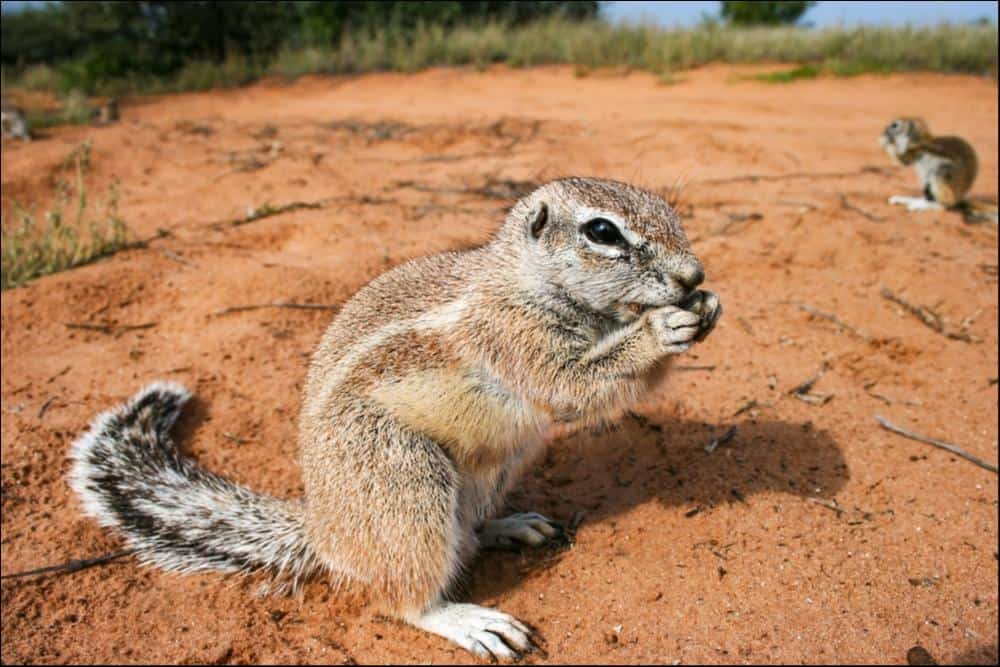Ground Squirrel
Ground squirrels are adept excavators and can dig colonial burrows larger than football fields!
Advertisement
Ground Squirrel Scientific Classification
Read our Complete Guide to Classification of Animals.
Ground Squirrel Conservation Status
Ground Squirrel Facts
- Prey
- Insects and larvae, amphibians, small mammals including mice, rabbits and other ground squirrels, eggs
- Main Prey
- Insects
- Group Behavior
- Solitary
- Colony
- Fun Fact
- Ground squirrels are adept excavators and can dig colonial burrows larger than football fields!
- Biggest Threat
- Habitat degradation and predators
- Most Distinctive Feature
- Standing up on hind legs to look around
- Other Name(s)
- Some members of the ground squirrel family include marmots, prairie dogs and chipmunks
- Litter Size
- Average of about 5 to 8, depending on species
- Habitat
- Grasslands, savannas, open forests, rocky or mountainous regions
- Predators
- Owls, hawks, eagles, raccoons, foxes, wolves, weasels, snakes, and more
- Diet
- Omnivore
- Average Litter Size
- 5 to 8 on average, depending on the species
- Lifestyle
- Diurnal
- Crepuscular
- Colony
- Sociable
- terrestrial
- Favorite Food
- Fruits, nuts and seeds
- Location
- North America, Europe, Asia, Africa
- Nesting Location
- Mostly burrows, but some species nest on the ground
Ground Squirrel Physical Characteristics
- Color
- Brown
- Grey
- Skin Type
- Fur
- Lifespan
- 3 to 15 years
- Weight
- 0.1 to 30 pounds, depending on the species
- Length
- 6 to 30 inches, depending on the species.
- Age of Sexual Maturity
- 1 year
- Age of Weaning
- Varies depending on species
- Venomous
- No
- Aggression
- Medium
View all of the Ground Squirrel images!
Ground squirrels are adept excavators and can dig colonial burrows larger than football fields!
Ground squirrels are rodents in the Sciuridae family. Many members of this group are called ground squirrels, but some are also known as marmots, prairie dogs and chipmunks. These rodents live mostly on the ground, although they can climb when necessary. They are expert diggers, adept at burrowing. Most species live colonially, although some are more solitary in nature. When they are outside their burrows, ground squirrels are most often eating or gathering food. They are most often noticed when they are standing up, looking around and surveying their environment for predators or other dangers.
Incredible Ground Squirrel Facts
- There are more than 60 species of rodents grouped together as ground squirrels.
- The ground squirrel tribes have undergone significant reorganization based on phylogenetic evidence since 2007.
- These rodents vary in size from just a few ounces to 30 pounds!
- Despite their name, ground squirrels can climb trees when they want.
- Some species hibernate up to eight months a year, while others do not hibernate at all.
Where to Find Ground Squirrels
Ground squirrels spend most of their time on the ground or in burrows. They are typically found in fields, pastures, grasslands or savannas. They are sometimes found in shrublands, forests, or in deserts or rocky areas. Many species prefer habitats that are primarily flat, while others thrive in mountainous regions. Areas of high visibility seem to be a priority for most species of ground squirrels. Many species live colonially and dig extensive burrow systems under large areas.
The species from the Marmotini tribe are found throughout most of the northern hemisphere, in Europe, Asia and North America. A few species live in Southeast Asia, dwelling in the forests and using primarily tree trunks and rotting logs for their burrows. Several species live in the deserts of the southwestern United States and Mexico, while others live in forests or open areas at elevations from sea level to high in the mountains. Ground squirrels native to Eurasia also live in a variety of habitats, depending on the species.
The ground squirrels from the Xerini tribe mainly inhabit Africa. They live primarily in open, dry, and grassy savannas and sometimes open or disturbed forests south of the Sahara. The cape and mountain ground squirrels are found as far south as South Africa. The Barbary ground squirrel, meanwhile, lives in rocky, mountainous areas in Morocco and Algeria. One species in this tribe, the long-clawed ground squirrel, also lives in parts of Asia, from northeastern Iran to southeastern Kazakhstan.
Colonial Burrows
As mentioned, ground squirrels often live colonially and build burrows underground. Individuals can dig large burrows on their own, but together, their excavations can be enormous. The California ground squirrel, for instance, may dig a burrow up to 30 feet long by itself, but working within a colony of up to 20 other individuals, the burrows can span hundreds of yards.
Scientific Names
Ground squirrels are rodents, from the order Rodentia. They belong to the Sciuridae family which includes all types of squirrels. Within the Sciuridae family, the Xerinae subfamily includes a large variety of species, including dozens of rodents known as ground squirrels from the Marmotini and Xerini tribes. These species include dozens of rodents named “ground squirrel,” as well as creatures known by other names. Marmots, chipmunks and prairie dogs, all members of the Marmotini tribe are considered ground squirrels, too, although for our purposes we will discuss mainly the species commonly known as ground squirrels.
In recent years, the arrangement of the taxonomy of the Sciuridae family has undergone significant reorganization. Researchers have carefully investigated the phylogenetic relationships between and within genera, resulting in moves within the family and the creation of new genera. Because this research is ongoing, any older source providing a comprehensive list of genera or species within this family should be viewed with scrutiny.
The genus Spermophilus, in the Marmotini tribe, was long considered the taxonomic home of most ground squirrels. However, beginning in 2007 many species were moved to other genera, including the marmots of the Marmota genus, the prairie dogs of the Cynomys genus, and chipmunks, which were divided into three separate genera of their own. New genera of ground squirrels, including Urocitellus, Ammospermophilus, Notocitellus, Otospermophilus, Xerospermophilus and others were also populated with former Spermophilus species.
The Xerini tribe, from Africa and parts of Asia, also includes around half a dozen species across a handful of genera.
Appearance
Ground squirrels, generally, look similar to tree squirrels but without the long, fluffy tails. Many of the known species look a lot like prairie dogs, especially when they stand upright on their haunches and look around. Some species have relatively long tails, while many others have tails that are quite short. Some are lean, while others are chunky. The smaller species are just six or seven inches long, but the larger species can reach lengths of 30 inches or more. These rodents can weigh as little as 0.1 pounds or as much as 30 pounds, in the case of some large marmots, and their weight varies with the season if they are a hibernating species. However, most species weigh around 1 pound or less.
Most of these rodents are gray to brown or reddish brown in color, with thick, short fur. A lot of the known species are a solid color, often with lighter undersides. However, some, such as the thirteen-lined ground squirrel, have ornate stripes and patterns running longitudinally from their heads down their backs, similar to the well-known chipmunk. The stripes mimic light and shadow and help to camouflage these species when they stand up in the grass.

Ground squirrel from the Xerini tribe eating a seed.
©iStock.com/Emmanuel Chansarel-Bourigon
Behavior
Ground squirrels are diurnal or sometimes crepuscular, meaning they are most active during the day or during the periods of dawn and dusk. Most species are gregarious and share their burrow systems with other individuals, sometimes forming colonies of two dozen or more. Other species, such as the thirteen-lined ground squirrel, are usually solitary.
Colonial ground squirrels emerge from their burrows together, early in the day, and work together to maintain vigilance against predators while they are out. By nightfall, they retreat back to their burrows, and some species plug the entrances, possibly for temperature control as well as protection from predators.
Some species enter full hibernation during a large portion of the year, though many other species do not hibernate or do so for shorter periods. Hibernating species use special burrows called hibernacula, sometimes segregating by sexes. These hibernacula are often well placed, below heavy vegetation where snow is likely to build up and help insulate the ground below. The duration of hibernation varies, but can last as long as eight months. The Belding’s ground squirrel of the western United States hibernates from late summer, as early as July, until April, avoiding both the hottest and driest months and the coldest ones, Hibernating individuals enter a state of torpor in which they greatly reduce their metabolic rate and body temperature, waking periodically to eat from their stored food supply.
A Mostly Terrestrial Life
As suggested by their name, ground squirrels spend most of their time on the ground. When they are seen by humans, they are often standing erect, looking around and scanning the area for potential danger. If they spot something amiss, they will dart to their burrow. Interestingly, ground squirrels are also occasionally found in trees. Most species can and will climb when they see fit to do so. Even large and cumbersome groundhogs, more commonly seen waddling through the grass, can climb trees.
Being mostly ground dwellers, these rodents are adept at burrowing. Researchers found that the length and depth of a ground squirrel’s burrow varies according to many factors. With the exception of large marmots, the size of the burrow seems to increase with the size of the species. The more social a species is, the longer the burrow systems appeared to be as well. Most species studied extended their burrows each year, so newer burrows were shorter than older ones. These rodents also dig their burrows at varying depths based mainly on the substrate where they live. Rocky ground makes deep burrowing more difficult, and sandy soils are more likely to collapse, leading the ground squirrels to burrow beneath harder layers of clay.
Diet
Ground squirrels are generally omnivores, although some species are primarily herbivorous. They eat a wide variety of foods, including nuts, berries, seeds, fungi, and the tender green parts of plants. Omnivorous species also eat various insects, including beetles, cicadas, crickets, grasshoppers, and different sorts of insect larvae. Some ground squirrels are specially adapted to hunt specific prey, with long snouts for digging up worms and insect larvae, or strong claws for digging insects out of rotting wood. Some species even eat larger prey, such as bird eggs, amphibians, and small mammals including mice, rabbits and even other ground squirrels.
During the spring and summer months, many species of ground squirrels spend the bulk of their time eating and storing food within their burrows. They gain considerable weight, with some species becoming obese before they enter their burrows to hibernate. This is essential to their survival. Tropical ground squirrels, however, do not hibernate or face seasonal food shortages, thus they do not gain excessive weight or store food.
Reproduction
Ground squirrels are generally promiscuous rodents, with both females and males having multiple mates, although this can vary according to species. The Arctic ground squirrel, for example, is polygynous, with one male having multiple female mates which he aggressively defends.
Mating season varies depending on the species and where they live. Most species have one litter per year. Each litter ranges from as few as a single offspring to more than a dozen. The average for many species is between about five and eight babies. Mothers care for their babies in their burrows for up to several weeks, moving them often to avoid predators. The offspring begin to burrow on their own after weaning. They reach sexual maturity usually within one year.
Predators
Ground squirrels are vulnerable to a variety of predators including owls, hawks, eagles, raccoons, foxes, wolves, weasels, and more. Snakes, particularly rattlesnakes, are formidable predators that attack both adults and their offspring. Some species, such as the California ground squirrel, have developed adaptations that help them to survive rattlesnake attacks. Mature individuals are immune to rattlesnake venom. They can flush their tails with blood, fooling the snake’s heat sensors and making themselves seem larger than they are. They have also learned to use discarded snake skins to camouflage their own scent and that of their offspring by rubbing the skins on their bodies.
Lifespan
The lifespan of a ground squirrel depends on the species. Some live only about three years on average, while others can live much longer. The Alpine marmot, for instance, lives up to 18 years. The IUCN Red List for Threatened Species lists most ground squirrels as species of least concern. Several, though, are listed as near threatened or vulnerable, and at least two species, the Perote ground squirrel of Mexico and Nelson’s antelope squirrel of California are listed as endangered.
Predators are a significant threat to ground squirrels, but habitat degradation may be a much larger concern. Habitat loss due to agricultural use and the timber, oil and gas industries has taken a toll on the most at risk species.
Relationship to Humans
Ground squirrels are often considered pests. They do considerable damage, especially in agricultural areas. They stick mainly to open areas such as fields, roadsides, and grasslands. However, they often inhabit areas close to farms and orchards. These rodents are particularly drawn to fruit and nut trees. They damage roots when excavating burrows, and they climb trees to pilfer the fruits and nuts. They also damage irrigation systems and can even destroy levies with extensive burrows. For this reason, ground squirrels are generally persecuted by humans in areas where they are destructive. Defensive efforts, aiming to prevent their spread into agricultural installations, are the best means of control.
View all 170 animals that start with GGround Squirrel FAQs (Frequently Asked Questions)
What do ground squirrels look like?
Ground squirrels are rodents that generally look similar to tree squirrels, but without the long, fluffy tails. Most are solid brown to gray, sometimes with lighter underparts, but others have stripes and other markings, usually running down their backs. Some species, including prairie dogs and marmots, are considerably chunkier than their leaner counterparts.
How big are ground squirrels?
Ground squirrels range from only about six inches long to more than 30 inches. They can weigh between 0.1 and more than 30 pounds, but most species average less than 1 pound.
How long is a ground squirrel’s tail?
Ground squirrels have tails of varying lengths. Some are very short, while others are nearly as long as tree squirrels, but not nearly as fluffy.
Do ground squirrels hibernate?
Some species of ground squirrels hibernate, while others do not. Hibernating ground squirrels enter a state of torpor and may remain in their burrows from six to eight months.
How many varieties of ground squirrels exist?
More than 60 species of ground squirrels exist across several genera. They are all part of the Sciuridae family of rodents. Since 2007, scientists have been working to reclassify members of the ground squirrel subfamilies based on phylogenetic information.
What makes ground squirrels special?
Ground squirrels are incredibly adept at burrowing, sometimes creating communal burrows larger than football fields.
Where do ground squirrels live?
Ground squirrels live in North America, Europe, Asia and Africa. They are found in a variety of habitats, from grasslands and savannas to open forests, and rocky or mountainous regions.
Do ground squirrels migrate?
Ground squirrels do not migrate, but many species are known to expand their territories year by year.
What do ground squirrels eat?
Ground squirrels are generally omnivores, although some species are primarily herbivorous. They eat a wide variety of foods, including nuts, berries, seeds, fungi, and the tender green parts of plants. Omnivorous species also eat various insects, including beetles, cicadas, crickets, grasshoppers, and different sorts of insect larvae. They also eat amphibians, bird eggs, and small mammals such as mice, rabbits and even other ground squirrels.
How many babies do ground squirrels have?
Ground squirrels usually have one litter per year, and depending on the species can have as few as one or as many as 15 or more offspring in each litter. Most species seem to average about 5 to 8 babies each year.
When do ground squirrels wean their young?
Ground squirrel mothers usually care for their young in their burrows for several weeks, often moving them to avoid predators.
How long do ground squirrels live?
Some species of ground squirrels live only about three years, while others, particularly the large marmots, may live much longer, up to 15 years.
Are ground squirrels rare?
Most ground squirrels are listed as species of least concern by the IUCN Red List and are not considered rare. However, some species are listed as near threatened or vulnerable, and at least two are listed as endangered.
Thank you for reading! Have some feedback for us? Contact the AZ Animals editorial team.
Sources
- University of California IPM, Available here: https://ipm.ucanr.edu/agriculture/citrus/california-ground-squirrels/
- Journal of Mammalogy/Kristofer M. Helgen, et. al., Available here: https://academic.oup.com/jmammal/article/90/2/270/894719
- Oregon Department of Fish and Wildlife, Available here: https://myodfw.com/wildlife-viewing/species/beldings-ground-squirrel
- Journal of Mammalogy/Dirk H. Van Vuren, Miguel A. Ordeñana , Available here: https://academic.oup.com/jmammal/article/93/5/1240/857780
- Alaska Department of Fish and Game, Available here: https://www.adfg.alaska.gov/index.cfm?adfg=arcticgroundsquirrel.printerfriendly
- Ojai Valley Land Conservancy, Available here: https://ovlc.org/ojai-wildlife/california-ground-squirrel/


















